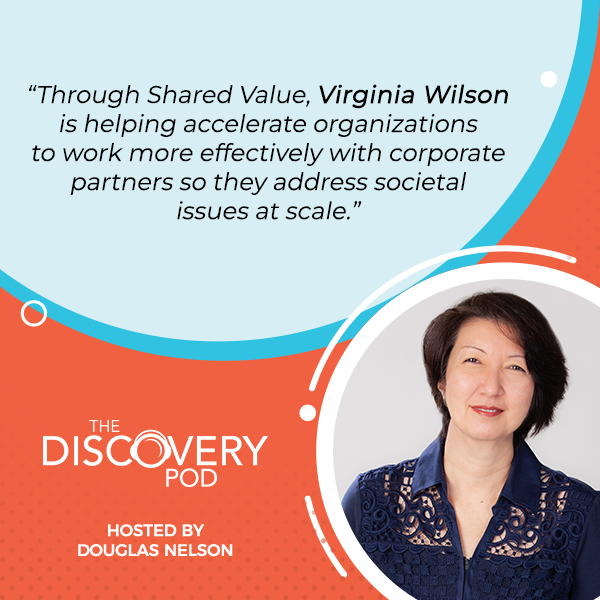
In the social sector, there can be an aversion to the word “profit.” But the reality will always be that in order for organizations to function, we need to have profit in one way or another. That includes those who are non-profit. Virginia Wilson believes that profit is not a dirty word because it helps address societal issues at scale. They best do that by what they call “Shared Value,” which is aligning purpose with profit. Virginia is the CEO of Shared Value Initiative Hong Kong, where they are building a community of leaders while also bringing together diversity and crossing cultural divides. In this episode, she joins Douglas Nelson to enlighten us more about the meaning of shared value, how it differs from ESG, and why it is the way to go. She also discusses the differences between corporate speak and social profit speak and how we can bridge the two for the betterment of all. Tune in to this conversation and learn fresh insights on leadership in the social sector.
—
Listen to the podcast here
Shared Value Initiative Hong Kong With CEO Virginia Wilson
In this episode, we have Virginia Wilson. She is the CEO of Shared Value Initiative Hong Kong. In our conversation, she goes deep on the differences between ESG and shared value initiatives, and why shared values initiatives are definitely the way to go. She shares some great examples of what a shared value initiative looks like in real time and real life on the part of corporations and the communities that they serve and that they work with. She also goes deep in explaining the differences between corporate speak and social profit speak and building a bridge between the two for the betterment of all. Please enjoy my conversation with Virginia Wilson.
—
Welcome, Virginia.
Thank you. It’s nice to be here.
It’s wonderful to have the chance to sit down with you over a nice conversation. We’ve been wanting to have the conversation for a while. It’s happening now. As a Canadian firm based in Vancouver, we have the privilege of working and living in a very diverse city that has a large Asian community. Many of our clients and colleagues have strong connections to Asia as do many of our audience. In this season, we’re speaking to a handful of social profit leaders who are leading Asian-based organizations to learn more about the great work being done in Asia and to share experiences. For our audience who aren’t familiar with Shared Value Initiative Hong Kong, can you explain what your organization does and who it serves?
We are a for-profit nonprofit. The concept of creating Shared Value is based in Harvard by Professor Michael Porter and Mark Kramer. It started about eleven years ago when their first article came out in the Harvard Business Review. After reading that article, the business community gravitated towards creating shared value and wanted to understand and learn how to create shared value. What does that mean? It means aligning profit and purpose.
A lot of times, we look at NGOs as purpose organizations, we call ourselves nonprofit, but there is no such thing as a nonprofit because you need to have profit. It’s just how you use the profit. Do you reinvest it into the shareholders or do you reinvest it into the stakeholders? When I look at ourselves, we are a nonprofit, but we still need to make a profit. It’s not a dirty word to us. We work with multinational companies and in our sister network across the globe to create shared value together, and it’s at scale. What does that mean? We address societal issues at scale. The companies that do that, do it well. There are great stories and case studies that we use to showcase that.
You mentioned that at scale. That’s an emerging issue in what we call the social profit world, which is the idea that the challenges in any given country or community are becoming greater as there are shared challenges of climate action and sustainability. It’s the idea that there’s going to be this flight to quality or flight to scale in organizations. Those organizations that are able to effectively lever up and bring more people into the tent working on those challenges are going to attract go greater resources and greater minds. It’s going to be more sustainable and ultimately more effective.
In reading about the beginning of the Shared Value Initiative and the Shared Value Movement, it seems like there was a tipping point of the smartest kids in class coming together and saying, “There must be a better way to do this scale and impact that is going to be necessary.” What is that better way in Hong Kong and how is it playing out on a daily basis?
We have a lot of multinationals in Hong Kong that are mainly focused on the finance industry. Some of our members include HSBC, AXA, AIA, City Corps, and lots of financial institutions that we work with. What are some of the issues that we look at? We look at the environment as a result of human decisions. Some of the things that we do are looking at how to seed sustainable thinking and sustainable decision-making in product development. I can give you an example. There is a product called No Fixed Address.
If you think about banks, you need to have a fixed address for compliance issues before you’re able to give someone a bank account. The Shared Value Initiative by Hong Kong Bank is that they created a product called No Fixed Address with NGOs in Hong Kong. They were able to give people who are in housing and who are unbanked the ability to open their own accounts.
When you want to leverage up a community, you need to be able to give them access to financial fitness understanding. Without that first baby step, you’re not able to get to the understanding of, “What do I do with a bank account? How do I use a bank account?” Even the basics of savings and checking. We were able to create a product that addressed a community that was unbanked predominantly.
When you want to leverage up a community, you need to be able to give them access to financial fitness understanding. Share on XHow would an initiative like that get started? Is that something that problems identified there in Hong Kong and then working with partners to identify it? Is it you supporting the corporate partner who’s trying to solve this problem perhaps on their own?
The corporate partner usually comes to us and says, “We want to be able to develop products for the community. How do we do that?” We’re not necessarily the experts in community gaps, but we work with NGOs. The NGOs will tell us what are the biggest gaps. When you work with the stakeholders, you’re able to identify what those gaps are. It’s about identifying the right problem. The solutions will come once you know what the exact problem is. It’s not trying to create the solution without understanding the problem properly. It is usually the problem.
That’s very true of the social profit sector. We’ve seen lots of initiatives with the solution before the problem is fully articulated.
I’ve seen it repeatedly over my career. It’s unfortunate because when you’re able to identify the right problem properly, you can motivate people to find the solutions.
You referenced that the Shared Value Initiative started about eleven years ago, but you already have chapters in over 30 countries on 6 continents. What are you seeing on the global scale in terms of the changes that corporations are leading and specifically, what are you seeing there in Hong Kong?
We have 5 initiatives, but we are in 30 countries. That’s maybe the difference because for example, India, Africa, and the US cover more countries than Africa. Africa covers the African continent for the most part. Australia covers New Zealand and Australia. We have 5 initiatives and we cover over 30 countries. It’s covering the corporates in the company, so all of our members or corporates. We do have some that are NGOs. We do work with some NGOs, but mostly with those, we’re working on teaching them how to work with the corporates. We’re the bridges to the conversation.
In your experience, what gets in the way of those conversations or what gets lost in the translation of shared value that isn’t there to help?
A lot. I have observed many mismatches and understanding in terms of timeframes and expectations, whether it’s expectations from the charity itself or from the corporate. Those mismatches oftentimes become barriers to projects happening or landing. It’s unfortunate because if you aren’t able to bridge those conversations and make sure both sides understand, and sometimes the side also includes government, and everybody is speaking with the same targets and goals, nothing gets off the ground.

Shared Value Initiative: If you aren’t able to bridge those conversations and make sure both sides understand, then nothing gets off the ground.
I was reflecting on a number of partnerships that we’ve been supporting over the last couple of years here at the Discovery Group. What you said about the timeline being one of the barriers to understanding rings true. What is the difference in a timeline that you see that if you’re leading an NGO, you should be paying attention to when you’re having those conversations with corporate partners?
Corporate partners have set targets. Their KPIs are quite immediate. One of the things about shared value is working with the corporate partners to look at the long-term and what long-term profit looks like and goes back to the sustainability conversation. NGOs are typically maybe a little bit slower, sometimes slow to react. The timeline is different because resources are different. People resources are different. Money resources are different. The corporates are going at the rate of rockets, and sometimes the NGOs are going at the rate of snails. You have that mismatch.
What I see as the biggest challenge facing the social profit sector in Canada, North America, and around the world is that the world around us is changing much more quickly than the work within the sector. It’s one of the reasons we were excited to have you on the show because your work is directly about helping to accelerate organizations to be better partners and work more effectively with corporate partners to different ends than is typically the case. That’s probably what it’s going to take for a lot of organizations. In your conversations with NGO leaders in your comment that they’re moving into snail space, how do you help change that trajectory or timelines that are driving their activities?
A lot of times, NGOs that I have seen are focusing on many activities and not necessarily the core activity. In NGOs, every activity is important. When you look at the purpose of some NGOs, if you are able to put aside some of the actors that are not necessarily your core focus, and you focus your resources and then work with the corporate, and they’re also working with you to focus their resources, then you can leverage that. I call it 1 plus 1 equals 3. It can make a difference, but you have to be focused. There are too many activities going on and too many programs running, but not enough resources. It folds in on itself.
Oftentimes with NGOs, there are too many activities going on or too many programs running and not enough resources, it folds in on itself. Share on XOne of the things that we say to organizations, particularly when we’re working with boards, is the word priority existed as a singular word. It’s priority, not priorities. For more than 350 years before, it was made plural. Maybe go back and think about what is the most important. What are the core purpose and activities? Try to strip away some of those things that are either nice to have or maybe nice to have, but slowing you down or preventing you from taking positive steps towards your organizational purpose or your mission. I’m curious how the translation goes the other way. When you’re working with many corporate partners on a rocket ship of a timeline, quarterly reporting, and annual KPIs, what is your messaging to your colleagues on that side of the aisle about being more effective partners with the NGOs?
It’s just as challenging honestly, but in a different way because you have to pull them back and slow them down. When we say stop and smell the roses, you have to rein the roses in. We do that through a lot of experiences and immersive experiences. The way that children and adults learn is we look at adult learning behavior and we need to address adult learning behavior. Once you get them on board, then you have huge amounts of buy-in because they see the value. It’s always getting it over the line to get them to see the value. Once that happens, then the investment does come and the projects take off. It’s quite interesting to watch.
Slow burn and then the rocket ship fires off. Many organizations, particularly on the corporate side, believe they’re doing their part because they’re following their corporate social responsibilities principles or their ESG, but there is a difference that you and your organization make very eloquently between corporate social responsibility and shared value. Can you share what that distinction is and why it’s important to move beyond corporate social responsibility?
Corporate social responsibility came as a result of philanthropy doing one thing and corporates needed to take on the rein. They were doing it through the foundations except through their own corporate foundations. People wanted to bring that responsibility closer to home. The thing is that that is not necessarily a part of the core business. A lot of times, CSR activities happen outside. They happen separately to what is the core business. What we need to do is make sure that the core business is the one that is addressing the societal issue because that’s the only one that can address it at scale when corporates are creating products and services that are in service of the people.
How could someone tell the difference from the outside between whether this flourishes on the outside of corporate social responsibility or whether this is the core business?
I can give you another example.
You can say a lot of financial institutions right off the top.
Debt collection department, losing money, hand over fist, and internal turnover. Nobody wants to work for a debt collection department. They couldn’t get staff. They were losing money because people were not repaying. The manager goes in and says, “Why is this happening?” Nobody can answer why people are not paying back and what was the problem. He said to his boss, “Give me three months. Let me go look at what’s happening and I’ll come back with something.” He went to engage in NGOs and ask the NGOs to ask the population in his community that is borrowing from them and to ask what the problem was. Any ideas about what you think might have been the problem?
Technology to make repayments.
I wish it was that simple, but it was a good guess. The problem was that people had a death in the family, loss of a job, bad financial planning, or their spouse had medical issues. They were real-life problems that people didn’t know how to handle because financial fitness is not necessarily part of our education system, and not necessarily something that parents teach very well. What happens is you get to adults and you start borrowing, and you don’t have good financial planning.

Shared Value Initiative: Financial fitness is not necessarily part of our education system.
You can become paralyzed when you don’t have a job, you cannot repay, something happens, and everything goes haywire. What they did was he went back and said, “Give me another three months. We have to stop all interest payments from this group of people and restructure all the loans.” Within three months, they did that. Within three months, 96% of people repaid. It went from something like $96 million in non-payments back to a flourishing business.
In six years, the staff wanted to go back to work in that department. They had waitlists for people who wanted to go and work because they were doing something that was good for the community. Not only that they created evaluation because they created intergenerational education for the kids. They created an assistant program for the community that helped the community itself. This is the core business of the bank, and the core business of the bank was addressing the community with no fixed address as well.
It’s something that we want to help people understand and learn about financial fitness. This is what CSB in action looks like. That’s the cleaner example because there are some that are more complicated and have a lot more things happening to them. This one was a very good one. The program still existed. The story that I’m giving you is 8 or 9 years ago.
Thank you for sharing that example because that’s making it clear. That is the operations of the business, and connecting to the community in a way that we don’t typically think of corporations acting. Certainly, the debt collection agencies aren’t the ones that people think of as in tune with the needs of the community necessarily. That does change this perspective and give us some insight.
One of the interesting things that I see happening in the sector is we’re in a recession or about into one. I read something in the paper that we’re coming out of the undeclared recession. This is silly. Wherever we are, there’s a general holdback or tenseness about where the economy may be heading on a global scale. What do you say to CEOs and corporations who are facing budget constraints as a result of those concerns? Why it’s imperative to continue working with Shared Value Initiative and the CSB work that you’re championing?
Shared value is part of a strategy. If you’re not using a shared value cap when you’re designing your strategy, then most likely you may not be around in that sustainability framework. If you keep taking from our resources, the people, and the environment, there is not going to be anything left. That business will probably not be around. That CEO might need to find a new job.

Shared Value Initiative: If you’re not using a shared value cap when you’re designing your strategy, then most likely you may not be around in that sustainability framework.
However the economy looks, if we don’t look at a regenerative economy, and not everything can be regenerative but it can be less. Not everything is perfectly circular because there’s no such thing, but you need to have the mindset. If you don’t have the mindset, you’re never going to get there. That part is for sure. The CEOs that don’t have that mindset, those companies probably won’t be around however long ago they started.
Either the company or the CEOs will go the way of the dinosaur.
I say it quite a lot when I do some of the training programs, “When people use the word sustainability. How long does that mean to you?”
At least to the next quarterly earnings call.
If you can’t put a number to it, you’re not going to be sustainable.
You’re talking a lot about system change. I appreciate the way you described that as a mindset. One of the things that we’re seeing in the social profit sector here in Canada in particular is what some people are calling the war on talent. There aren’t people at the senior levels to do the work and lead the organizations. We’re seeing a real generational shift in who’s leading as the Boomers retire and the youngsters come in behind them. Are you seeing a similar thing in Hong Kong and the work you see going on across the Shared Value Network?
I love working with the younger generation. I see so much energy. When you see great intent, it is wonderful to watch. I oftentimes find that maybe if the older thinking doesn’t change, it gets in the way. You have to have all of those pieces. We talk about authentic leadership and servant leadership, and all of the different words that people have come up with. I think leadership has to come with care. If you care, those are actions that you can do.
Leadership has to come with care. Share on XOnce you care, you’ll do all of those things. Working with the younger generation, they care. They may not know all of the tips. They may not have all of the experience. They may run into some things, make some mistakes, and some blunders. If you care enough to teach them and let them try, and then make them become, “You’ve run into a wall. You can now have to drive yourself out of that one,” then I think there is hope. Boomers retiring is okay. The ones who are around will teach rather than tell.
That’s speaking of shifting mindsets for many. There are great examples of leaders who are maybe in the last chapter of their careers that are seeking to give back and cultivate the next generation of leaders. We’re seeing it quite a lot in Canada. The number of women leading organizations, and the cultural and ethnic diversity of organizational leaders is changing for the better almost on a daily basis. It’s part of the shifting mindset.
It is about how we keep that sustained so that our sector reflects the communities that we serve, which shouldn’t be quite as revolutionary as a statement as it still is now. Speaking of leadership in the sector, you spent a lot of your professional life working in the telecommunications industry. I’m curious about what brought you to the social profit sector. What skills have you brought with you from the private sector that have helped you to be as successful as you’ve been?
When my son got diagnosed with autism at the age of two, I start looking and went deep dive into understanding early childhood education and special needs education. I then got invited to several boards to bring a different skillset and a different lens to problems. When he was more settled and I decided to work again, I didn’t want to go back into the private sector. That’s what brought me into the education sector at first.
Now, I was doing different things with understanding how to bridge these conversations, being able to have conversations with the people funding us with the CSR programs, and everything that we talked about here. I said, “Why aren’t we part of the core business?” I heard Michael Porter speak in 2016 about shared value. I was still running an NGO myself. I was like, “I’m doing this.” He’s now able to help me put it into perspective. A few years later, I came out of the early childhood sector and was looking around. The head hunter said, “There’s a job.” I laughed because I didn’t know it was Shared Value Initiative.
It sounds too perfect. It can’t possibly exist.
Shared value was something that I had believed in as a win-win because I started working with insurance companies for special needs in Hong Kong to develop products for special needs before I came here. I thought that this was the next step to the evolution and that’s how I’m here. It was a huge learning curve, especially with the financial institutions. I’m working with them. It’s been quite wonderful because when you get to see products developed, it’s very cool.
The examples you’ve shared with us to date do change the lives of the people who are on the beneficiary end of that in a way that’s different than the beneficiaries typically receiving value from an NGO.
I also think that the corporate, when you look at that piece, they need to be able to measure. One of the key parts of knowing whether or not you have been successful is measuring that success, and how to translate that success into whatever form that common measurement may be. In our world, it’s money. What is the bottom line? When you look at corporate investment into developing these products, there has to be a measurement of what that looks like for them. In Shared Value Initiative, we helped develop the indicators to look at what that looks like because if we can’t measure, then we don’t know we’ve succeeded, and how to translate that into communication so that people can see it.
You’ve been with the organization now for a while. You’ve got great examples that you’re sharing, talking about that mindset shift. What are you looking forward to?
I like rolling up my sleeves and doing things. I like to make things happen. Every time there’s a new project or something that comes up, I look forward to every next project that comes into my scope. I like to see change happen. This has allowed me to do that. Right now, it’s working for me in this way. Sitting on boards has its absolute value if what you bring to the table is valued. I have a specific understanding of the sector. If I could bring that to more people or more understanding of leadership, that would be what I would be looking forward to.
It sounds like what you’re looking forward to is a slightly different version of what you get to do every day in your current role.
I hope so.
For our audience who are interested, where can they learn more about Shared Value Initiative Hong Kong or other organizations across the network?
They can go to SharedValueHK.org to learn more and then the links to the network are all on there. When you google Shared Value, it’s not just Shared Value because that’s the terminology of a concept. The concept is that we have stakeholder capitalism. We have B corps. There are many that bring the same value to the table. I’m not an advocate of one over another. I think that this is the piece that if everybody has the mindset to work with all of the different companies that are trying to bring stakeholder value into the conversation for corporates, then they should be doing it. Shared Value is definitely one of them, but not the only one.
We’ll encourage people to check that out to learn more about the great stories that Virginia has been sharing with us. Virginia, thank you so much for being on the show.
Thank you for having me.
Important Links
About Virginia Wilson
 Leading private and social enterprises for over 25 years in multilateral, culturally diverse environments, Virginia is passionate about bringing to life innovations that impact our society. Virginia has a demonstrated track record of securing strategic partnerships between corporations, governments, and non-profits to deliver on social impact projects.
Leading private and social enterprises for over 25 years in multilateral, culturally diverse environments, Virginia is passionate about bringing to life innovations that impact our society. Virginia has a demonstrated track record of securing strategic partnerships between corporations, governments, and non-profits to deliver on social impact projects.
She started her career in telecommunications, building satellites, and the distribution of free-to-air television across 60 countries in Asia. Seeing the uptake firsthand, Virginia focused on education, believing that investing in people is the key driver for impactful change. Bringing together diversity and crossing cultural divides is a pathway to create Shared Value in our world, aligning purpose with profit. After serving on the board of several educational institutions, Virginia is now a member of the Board of Directors of the Adecco Group Foundation in Switzerland a social innovation lab, incubating and accelerating new solutions in the world of work.



